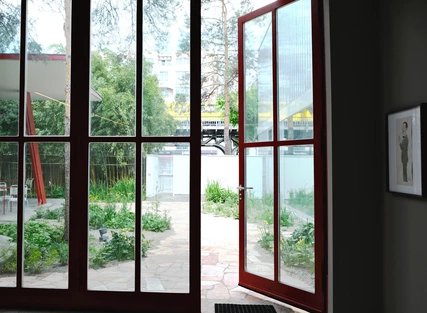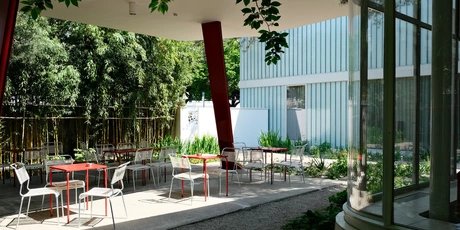
The Kleine Grosz Museum
Permanently closed since November 2024
Please note: The Kleine Grosz Museum has been permanently closed since November 2024.
The Swiss gallerist and collector Juerg Judin has provided the renovated petrol station at the Bülowstrasse for the Kleine Grosz Museum for five years.
An intriguing site: The restoration to a house and studio was rewarded with the architecture award in 2009. And indeed, the architecture icon from the 50s lies in the same neighbourhood that once influenced the artist Georg Grosz: in Schöneberg. Grosz worked at the “Theater am Nollendorfplatz” as production designer, and it was here that he witnessed the downfall of the empire and the rise of the National Socialist party.
Gross becomes Grosz

Born as Georg Gross in Berlin in the year 1893, Grosz captured social issues in his work right from the beginning. In fact, he changed his German name to its American-sounding version Geroge Grosz in the year 1916, in order to protest against patriotism and the war. Grosz developed a platform for political avantgarde art as well as political and social critique by establishing the publishing house Malik-Verlag together with the brothers, John Heartfield and Wieland Herzfelde.
“PropaganDa-Da George Grosz” and “MonteurDaDa John Heartfield” formed the basis of Dadaism in Berlin – simultaneously sending out warning notes against the emerging dangers of the policies of the National Socialist party. Classified by the Nazis as degenerated artists, Grosz went into exile in the US in the year 1933– and returned to Berlin only shortly before he died in 1959.
Impetus to critical discourse
The Kleine Grosz Museum is now a memorial dedicated to the artist and his significance for the city of Berlin. It is not just about the display of the works of Grosz. Setting out from an altercation with the character and history of this critical and disputatious individual and artist, it is also geared towards encouraging people to take the present social challenges head-on.
You will enter the exhibition through the former workshop that is linked to a small cafe. On the ground floor of the new building, you will find a permanent multimedia exhibition that throws light on the life and work of Grosz, whereas on the top floor, you will find temporary exhibitions based on the artist and his creative work.
Sight-seeing places near the Bülowstrasse

There is another extraordinary museum close to the Kleine Grosz Museum - the URBAN NATION Museum. The latter is devoted to the topic Urban Art. You can discover several more murals and street art works as you take a stroll along the Bülowstrasse.
